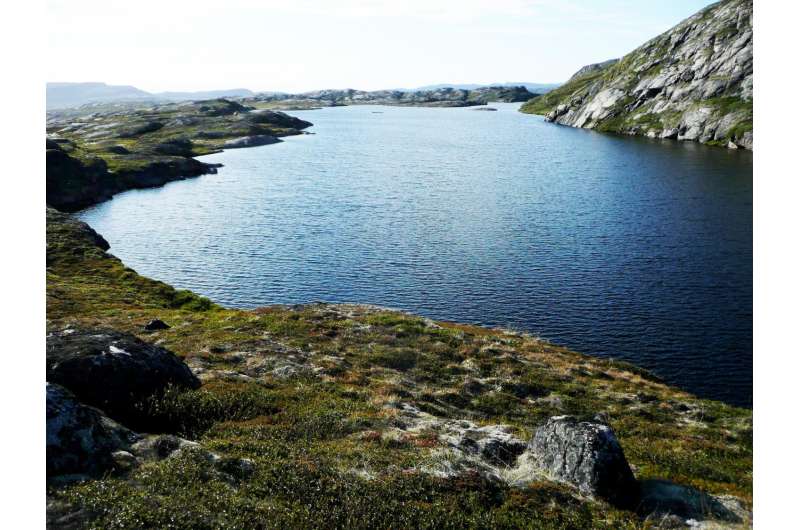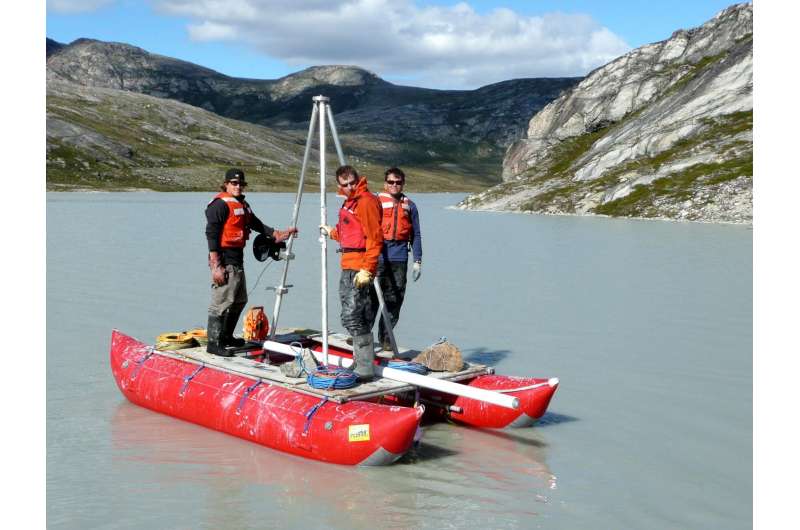A new study uses aquatic leaf waxes to study the history of precipitation at this lake in western Greenland. Credit: Jason Briner
The history of Greenland's snowfall is chronicled in an unlikely place: the remains of aquatic plants that died long ago, collecting at the bottom of lakes in horizontal layers that document the passing years.
Using this ancient record, scientists are attempting to reconstruct how Arctic precipitation fluctuated over the past several millennia, potentially influencing the size of the Greenland Ice Sheet as the Earth warmed and cooled.
An early study in this field finds that snowfall at one key location in western Greenland may have intensified from 6,000 to 4,000 years ago, a period when the planet's Northern Hemisphere was warmer than it is today.
While more research needs to be done to draw conclusions about ancient precipitation patterns across Greenland, the new results are consistent with the hypothesis that global warming could drive increasing Arctic snowfall—a trend that would slow the shrinkage of the Greenland Ice Sheet and, ultimately, affect the pace at which sea levels rise.
"As the Arctic gets warmer, there is a vigorous scientific debate about how stable the Greenland Ice Sheet will be. How quickly will it lose mass?" says lead researcher Elizabeth Thomas, PhD, an assistant professor of geology in the University at Buffalo College of Arts and Sciences who completed much of the study as a postdoctoral fellow at the University of Massachusetts Amherst.
"Climate models and observations suggest that as temperatures rise, snowfall over Greenland could increase as sea ice melts and larger areas of the ocean are exposed for evaporation. This would slow the decline of the ice sheet, because snow would add to its mass," Thomas says. "Our findings are consistent with this hypothesis. We see evidence that the ratio of snow to rain was unusually high from 6,000 to 4,000 years ago, which is what you would expect to see if sea ice loss causes snowfall to increase in the region."
University at Buffalo researcher Elizabeth Thomas holds half of a sediment core collected from the lake in western Greenland where the study was sited. Such sediment cores contain aquatic leaf waxes that reveal information about the history of precipitation at a site. Credit: Douglas Levere
The research was published on May 23 in Geophysical Research Letters, a journal of the American Geophysical Union.
Aquatic plant leaf waxes as a record of snowfall
Thomas' research looks to understand how precipitation changed in the past, with an eye toward better predicting how modern warming will affect the Earth.
"We are using the past to see what might happen in the future," she says.
Aquatic leaf waxes are a relatively new tool for completing this work. They reveal information about the seasonality of precipitation—how amounts of ancient summer rain compared to amounts of ancient winter snow.
To understand how aquatic leaf waxes function as a historical record, you need to know a little about aquatic plants. In the Arctic, these organisms survive on lake water, and use hydrogen atoms from this water to produce wax coatings on leaves.
Members of the research team collecting lake sediment cores from a coring platform in Western Greenland. From left: Stefan Truex (at the time, a UB undergraduate geology student, now at Aztech Technologies); Nicolás Young (at the time, a UB geology PhD student, now an Assistant Research Professor at Lamont Doherty Earth Observatory); Sam Kelley (at the time, a UB geology PhD student, now a postdoctoral fellow at Waterloo University). Credit: Jason Briner
These hydrogen atoms are the key to studying precipitation: In years when the ratio of summer rain to winter snow in a region is high, lake water and aquatic leaf waxes end up containing high levels of a rare form of hydrogen called deuterium, which is heavier than "normal" hydrogen. (This is because summer rain holds more deuterium than winter snowfall.)
In contrast, in years when snow is relatively abundant, aquatic plants start producing waxes with less deuterium.
This is what Thomas and her colleagues saw when they extracted a long, cylindrical sediment sample from a lake bottom in western Greenland. The mud contains ancient leaf waxes, with the oldest at the base of the column and the youngest at the top.
By dating and analyzing thin slices of the sample, the team determined that aquatic leaf waxes had low levels of deuterium from 6,000 to 4,000 years ago.
This is exactly what researchers would expect to see if the warm temperatures of that time had fueled sea ice loss, leading to increased Arctic snowfall and a decline in deuterium in lakes, Thomas said. She acknowledged that it's possible that a drop in summer rainfall accounted for the changes in deuterium, but says a rise in winter snowfall is the more likely explanation, as scientists have found independent evidence that the region was wetter 6,000 to 4,000 years ago.
More information: Elizabeth K. Thomas et al, A major increase in winter snowfall during the middle Holocene on western Greenland caused by reduced sea ice in Baffin Bay and the Labrador Sea, Geophysical Research Letters (2016). DOI: 10.1002/2016GL068513
Journal information: Geophysical Research Letters
Provided by University at Buffalo


























